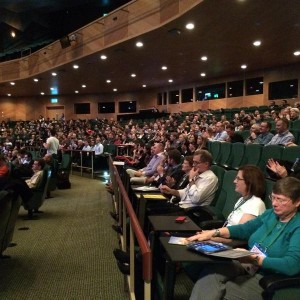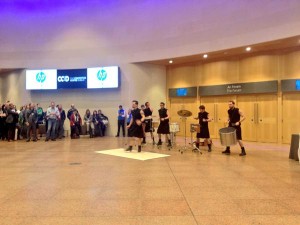After a day and a half of tutorial sessions, it was time for the main event to begin! The conference portion of EuroSTAR 2014 started in the same way as the end of the day, with a flurry of noise and excitement – but more about that in a moment…
The conference commenced with opening remarks from Paul Gerrard, who welcomed us all to Dublin. He encouraged us all to stand up and introduce ourselves to the person next to us. (Of course, his request to say “Hi, my name’s Paul” was met by hundreds of voices saying “Hi, my name’s Paul”!)
We were introduced to the programme team, who (along with a panel of 47 reviewers) had narrowed-down 456 submissions from 35 countries to select the sessions which best addressed the conference theme of Diversity, Innovation, Leadership. That diversity, he outlined, was also represented in the programme lineup, with many countries being represented for the first time.

The first keynote came from Professor Andy Stanford-Clark, who began his introduction to the “Internet of Things” by showing us his own home-built solutions which he’d built over the past decade. Some of these were extremely clever (setting up a Twitter account for his house, which would publish notifications at convenient moments, such as when he missed a phonecall) whilst others were slightly more macabre (an electronic mousetrap which – on a “MouseEvent”! – would alert him that the trap needed clearing and resetting).
Such homebrew solutions are now largely redundant thanks to the rising popularity of micro-computing solutions such as the Arduino and Raspberry Pi, and the falling costs of components, making it easier and cheaper for commercial off-the-shelf alternatives to emerge, with energy “smart meters” being one of the main in-vogue examples right now.
Andy looked at where things were heading, and proposed that companies are looking to do interesting things with the data that such devices are producing. His examples included real-time vehicle tracking information (such as a monitoring system for the Isle of Wight ferry system which he originally built as a pet project, but which the ferry companies have now adopted as part of their business offering) or notifications from your appliances about the most cost-efficient time to, for instance, load your washing machine.
There are new challenges for testers within the Internet of Things, not least in finding ways to simulate the unique properties of an IoT environment. Scalability is obviously a huge issue; can your system cope with thousands of devices disconnecting and re-connecting in large simultaneous volumes? What happens to your device if bandwidth is at a premium? When dealing with such message packets, every byte counts – are you broadcasting/receiving even the slightest bit of extraneous information?
In the first track session of the day, I watched Anna Hoff speaking about “Taking Back Your Own Reins”. Anna told a story which I could closely relate to, about how her life was full of bountiful opportunities, but there were so many that it engulfed her life (she spoke of how confused she had been about dealing with “The Pile” in her head). Anna discussed how she had taken control with the help of a coach, who taught her to outline her dreams and then begin to address the things which were holding her back.
Anna gave a lot of practical tips about how to organise and declutter, ranging from physically throwing away objects and artifacts which you no longer need, to compiling her daily tasks into a monitorable Excel sheet (complete with graphing capabilities to reinforce her progress). She also gave some wise advice about not trying to tackle too many goals at once, for this often leads to making no progress in anything!
As well as looking forward, Anna advised us not to forget what we’d achieved. Visualising your goals, as well as your achievements (such as via a charm bracelet, or a fishbowl full of completed post-its) can improve your chances of remaining motivated and continuing that drive onwards to your next goal.
Next, I finally had a chance to hear from the illustrious Rikard Edgren. I’ve only started attending conferences and participating in Twitter discussions during the past year, and during that time, two things have become evident: Lots of people quote Rikard in their work, and also Rikard doesn’t have a Twitter account, so I’ve heard lots about him but never had the chance to speak to him in person!
Rikard’s session was themed around “Trying to Teach Testing Skills and Judgement”, and was a simulated version of the “Think Like A Tester” course which he teaches with Henrik Emilsson as a vocational programme in Sweden. We heard that they help new testers to acquire tacit (intangible) skills such as critical thinking, rapid learning, and realising when testing is “good enough”. These are hard skills to teach, but through practical exercises, their students get a chance to hone these skills.
As a group, we tried to solve one such puzzle that they set for students – we got frustratingly close to a solution, but ran out of time. Rikard promised that the exercise would be available in the Community Hub for those who want to try it further – I expect that most of my free time on Wednesday will be absorbed with trying to do just that!
The day concluded with a keynote from Rob Lambert, “Continuous Delivery and DevOps: Moving from Staged to Pervasive Testing”. This was an experience report about NewVoiceMedia’s move from large, infrequent releases (the kind of which I’ve observed at other organisations which can produce slow, boring and ineffective testing) to a continuous delivery culture.
Moving to weekly releases allowed their development team to react faster to customer nees, and to achieve a quicker feedback loop on what they were developing. This naturally produced its own testing bonuses: with such frequent releases, automation of time-consuming checks was a must, and this actually created more opportunities for manual exploration and discovery. These manual sessions are submitted and collated into a single system via Confluence and a Google Forms page.
Rob outlined the supporting processes which enabled his team to meet the challenges of continuous delivery. These included dogfooding (or “company-wide pre-production testing” as he more eloquently put it!), monitoring and gathering analytics from their live systems; getting testing (rather than testers) recognised as the centre of the business universe; and constant reviewing and reduction of the cycle time.
The day didn’t end quietly, either! After Rob’s keynote, five talented drummers arrived on-stage and guided delegates down the escalators to the lobby, where they closed proceedings for the day with a feast of drumming and dancing. After that, there was just time to grab a quick post-conference drink at the HP Expo Party, before boarding the buses for the conference dinner. It was a splendid end to a fantastic day, and I’m looking forward to the huge number of sessions which will be on offer tomorrow!

